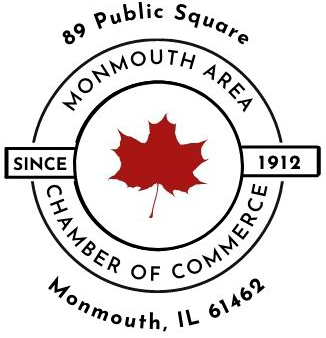In the Stephen King novella The Body, a group of young boys goes on a quest to find a corpse, rumored to be lost in a remote area. The story inspired the 1986 coming-of-age film Stand by Me.
A similar scenario unfolded near Monmouth in the summer of 1946, with one key difference — the boys who discovered a corpse in a remote area came upon it quite by accident.
One of the discoverers, who was 13 at the time, recently related the story to me. Chuck Hart, who today lives in King George, Virginia, contacted me about researching an unsolved murder case into which he and his friends were unwittingly drawn. Specifically, he hoped to track down a photo taken of him and his fishing buddy, Tommy Smith, by a Rock Island Argus photographer after they had stumbled upon the body of the victim.
To set the scene, the city of Monmouth’s current waste transfer station on South 11th Street is located just east of a former factory which turned out sewer tile and paving bricks that provided the infrastructure for many Midwest cities. The Monmouth Mining and Manufacturing Co. (known locally as the 3M plant), had burned 25 years earlier and all that remained was a pond (a former clay pit), weeds and trees.
Along with the city dump and a police firing range known as “Bullet Hill,” the 3M site was a favorite hangout for kids in that neighborhood, including Hart, who lived at 525 South 11th St., and Smith, who lived at 1126 East 7th Ave. The property stood just beyond the city limits and the pond, which had by this time been divided into two ponds by a road leading to the city dump, was attractive for fishing and rafting.
On the morning of Wednesday, June 5, Smith, Hart and several friends had gone to the south 3M pond, intent on spending the day fishing. At about 2 p.m., Smith and Hart decided to try their luck at the north pond. After their lines became tangled, Smith went up to the road and headed east to find his own spot along the south bank, which was topped by a barbed wire fence. According to Hart, “the bank was narrow and rough and you had to pick you way along it. Tommy’s first report was, ‘There’s a man over there.’ His second on his second trip was, ‘He is sleeping.’”
Hart, who was three years older than Smith, took a look and immediately said they needed to go tell the other boys.
One of the boys at the south pond, 10-year-old Frank Galusha, remembers that day. “At first we didn’t believe them, but we went over and saw the guy, who we thought was asleep,” he said. “When he didn’t move, we threw rocks at him.”
A 15-year-old companion, Jerry Robinson of Viola, was visiting his uncle, Truman Van Tine, who ran a grocery out of his home on South 11th. According to Hart, “Jerry ran real fast back to the Van Tine place,” where his uncle called Sheriff Louie Peterson at 2:45 p.m.
After Peterson and his deputy confirmed that the victim was dead, they called Dr. Firth, the coroner. They were joined at the scene by police chief Ray Nevius and state’s attorney Henry Lewis. It was soon learned that the victim was Eldon J. Belt, 60, a widower who lived in a trailer behind the G & M filling station at 1106 West Broadway. It was also immediately apparent that Belt was the victim of murder, as a rope with a slip knot was tied tight around his neck.

The motive appeared to have been robbery, as Belt’s pockets had been turned inside out and no wallet was on his person. A valuable diamond ring was still on his finger, but it was on so tight that the funeral home later had trouble removing it. Bits of cloth were found on the barbed wire fence and one of Belt’s shoes was found outside the fence, so it appeared the assailants had tossed his body over the fence, perhaps hoping it would land in the pond and go undiscovered.
At the mortuary, Belt was formally identified by G & M filling station owner Frank Bergren, who had been his employer until a few months earlier. An autopsy determined that he had died of strangulation and had been dead 12 to 13 hours when discovered.
The evening of the murder, Belt had visited his daughter Charlene Caldwell, north of Monmouth. It was believed he had later purchased some beer, which was found untouched inside his trailer, and had stopped in for a drink at a South Third Street tavern at about 9:30. There were rumors that he had gone to a bar in Gulfport and picked up two hitchhikers from Iowa, but the story was never confirmed. What was confirmed was that Belt’s 1938 Chevy sedan was missing.
At 2 a.m. the next morning, Sheriff Peterson learned that Belt’s car had been found abandoned, three miles outside Mount Sterling, 70 miles south of Monmouth. The license plates had been removed. A story, which was later found untrue, was that two young men had been seen leaving the vehicle and were hitchhiking toward Quincy. Peterson met state investigators at Mount Sterling the next morning and a fingerprint expert dusted the car, finding three good prints, which were submitted to the state crime lab.
A mysterious twist to the story was that minutes after Belt’s body had been retrieved, authorities came upon a dazed woman just a few hundred yards east on the same gravel road, who claimed she had been savagely beaten and robbed by two young men, who were driving a car similar to Belt’s. She was 45-year-old Mrs. Arlie Smith Sharp Delaney, estranged from her husband and with a reputation for getting in trouble. She was taken into custody for questioning, but had a good alibi against being the murderer, as she had spent the previous night in the city jail on an intoxication charge.
Mrs. Delaney’s story grew stranger. After she was released from the county jail, where she had been held for questioning, she stopped by the sheriff’s office and told the officers she was going to the hospital for X-rays to see if her jaw was broken. Later that same day, she was allegedly beaten up again while walking along South Main with her boyfriend. A man came across the street and knocked her into the door of the White House Dairy, breaking the glass. A few weeks later, she was arrested in Galesburg for stealing money from a soldier in a tavern. She was found to be carrying brass knuckles and claimed falsely that Sheriff Peterson had given her permission to carry them.
Convicted for stealing the money and sentenced to a year in prison, Mrs. Delaney apparently proved to be an unreliable witness, even if her assailants were also Belt’s killers. No suspects were ever arrested for the Belt murder and the case remains open to this day.
Eldon Belt’s life story was a sad one. Born in 1886, he married Lillian Frankenberry in 1913, and the couple farmed in the Aledo area. Two days after their fifth child was born in 1925, the baby died, and hours later Lillian died, leaving Belt a widower with four young children. Two years later, he remarried. His only son died at 22 in 1942, and his second wife died in December 1945, just months before his murder.
After leaving Aledo, where he had also worked as an auto mechanic, Belt operated the Chicken Bank coal mine northeast of Monmouth and later worked at the G & M filling station. In probate court, his entire estate was valued at $2,500, which would have included the automobile and diamond ring. He was buried In a Joy cemetery.
One of Belt’s grandchildren, Gary Burkett of Monmouth, has been searching for information about his grandfather’s death for years. He provided me with the coroner’s photo of the body.
Due to a flooded basement in the Warren County sheriff’s office where records were stored, files from the case cannot be located. Two stories about the murder were published in the Argus, but without a photograph, so Chuck Hart is still in search of that elusive memento from the unforgettable day. His partner in discovery of the body, Tom Smith, died in 1997.

by Jeff Rankin
Editor and historian for Monmouth College. Avid researcher of western Illinois history for 40 years. FB and Twitter. jrankin@monmouthcollege.edu



